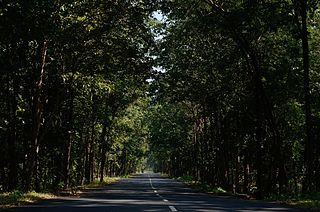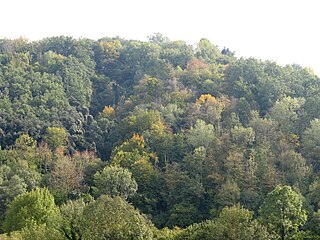Origins
Joint forest management is concept of developing relationships between fringe forest groups and forest department on the basis of mutual trust and jointly defined roles and responsibilities for forest protection and development. Joint Forest Management originated in West Bengal in 1988 . The major hardwood of Arabari Forest Range is sal, a commercially profitable forest crop. Ajit Kumar Banerjee, a silviculturist, working for the Forest Department as the Divisional Forest Officer, was conducting trials which were constantly being disturbed by grazing and illegal harvesting by the local populace. At the time there were no initiatives for sharing of forest resources between the government and the locals, with the government considering many of the locals no more than "thieves". [5] The forest official, against the suggestions of his co-workers, sought out representatives of eleven local villages and negotiated the terms of a contract with an ad hoc Forest Protection Committee. The initial program involved 612 families managing 12.7 square kilometres of forests classified as "degraded". 25% of profits from the forests were shared with the villagers. The experiment was successful and was expanded to other parts of the state in 1987. JFM is still in force at Arabari. [2]
A few years later, Joint Forest Management was employed in the state of Haryana to prevent soil erosion and deforestation. In 1977, villagers were persuaded that instead of grazing on erosion-prone hills, building small dams would help agricultural output on areas currently under cultivation. The program led to reforestation of many hills in the state. However, officially the state of Odisha remains the first to pass the first resolutions for JFM [6]

Forestry laws govern activities in designated forest lands, most commonly with respect to forest management and timber harvesting. Forestry laws generally adopt management policies for public forest resources, such as multiple use and sustained yield. Forest management is split between private and public management, with public forests being sovereign property of the State. Forestry laws are now considered an international affair.

The Indian Forest Service (IFS) is one of the three All India Services of the Government of India. The other two All India Services being the Indian Administrative Service and the Indian Police Service. It was constituted in the year 1966 under the All India Services Act, 1951, by the Government of India.

The Programme for the Endorsement of Forest Certification (PEFC) is an international, non-profit, non-governmental organization which promotes sustainable forest management through independent third party certification. It is considered the certification system of choice for small forest owners.
There are four categories of protected areas in India, constituted under the Wildlife Protection Act, 1972. Tiger reserves consist of areas under national parks and wildlife sanctuaries. There are 53 tiger reserves in India. As of January 2023, the protected areas of India cover 173,629.52 square kilometres (67,038.73 sq mi), roughly 5.28% of the total geographical area of the country.
Hari Singh (1910–2003) was the Inspector General of Forests of India in the 1960s. Shri Hari Singh came from a find tradition of great Indian Foresters. Among several other awards, he was awarded the Member of the Order of the British Empire (MBE), a distinguishing honor bestowed upon him by the British Government. He held India's highest office of forest administration, namely, Inspector General of Forests, from 1964 to 1969, and graced innumerable national and international bodies on the development of the forestry sector.

Arabari or Arabari Forest Range, is the name of a forest range in the West Midnapore district of West Bengal, India. Conservation efforts were begun in 1972 by an Indian Forest Service officer Shri Ajit Kumar Banerjee, Divisional Forest Officer (Silviculture) in an area of 1,272 ha by involving local people living around the forest boundary through a voluntary participation process. This process of greening the forest was brought about by setting up Joint Forest Management committees consisting of the local villagers and as result of their efforts a forest which was initially almost worthless became an economic boon to the villagers; the value of the forest area multiplied several times. Under this scheme the villagers actively involved with the conservation efforts in the forest derived the benefits of employment in silviculture and harvesting, sharing 25% of the profits from the forest produce and to collect firewood and fodder from the forest area on a nominal fee. This scheme is still practiced in Arabari.

Social forestry is the management and protection of forests and afforestation of barren and deforested lands with the purpose of helping environmental, social and rural development. The term social forestry was first used in 1976 by The National Commission on Agriculture, when the government of India aimed to reduce pressure on forests by planting trees on all unused and fallow lands. It was intended as a democratic approach to forest conservation and usage, maximizing land utilization for multiple purposes.
A "Common Important Forest" in India is a forest governed by local communities in a way compatible with sustainable development. Such forests are typically called village forests or panchayat forests, reflecting the fact that the administration and resource use of the forest occurs at the village and panchayat levels. Hamlets, villages and communities of villages may actually administer such a forest. Such community forests are usually administered by a locally elected body, usually called the Forest Protection Committee, Village Forest Committee or the Village Forest Institution. Such committees are known as Van Panchayats in the Kumaon Division of Uttarakhand, Forest Co-operative Societies in Himachal Pradesh and Van Samrakshan Samitis in Andhra Pradesh. Legislation pertaining to communal forests vary from state to state, but typically the state government retains some administrative control over matters like staff appointment, and penalization of offenders. Such forests typically conform to the IUCN Category VI Protected Areas, but protection may be enforced by the local communities or the government depending on local legislation. Maharashtra is the state with the most forest land while Haryana has the least.
Kaziranga National Park in India has a good conservation history, especially due to its efficient management policies. In spite of the efficient conservation policies there are some loopholes in the conservation policies.

Forestry in India is a significant rural industry and a major environmental resource. India is one of the ten most forest-rich countries of the world. Together, India and 9 other countries account for 67 percent of the total forest area of the world. India's forest cover grew at 0.20% annually over 1990–2000, and has grown at the rate of 0.7% per year over 2000–2010, after decades where forest degradation was a matter of serious concern.
Private landowner assistance program (PLAP) is a class of government assistance program available throughout the U.S. for landowners interested in maintaining, developing, improving and protecting wildlife on their property. Each state provides various programs that assist landowners in agriculture, forestry and conserving wildlife habitat. This helps landowners in the practice of good land stewardship and provides multiple benefits to the environment. Some states offer technical assistance which includes:
Today, forest and woodland cover in Uganda stands at 49,000 km² or 24% of the total land area. Of these 9,242.08 km² is tropical rainforest, 350.60 km² are forest plantations and 39,741.02 km² is woodland. 30% of these areas are protected as national parks, wildlife reserves or central forest reserves.

The Cross River National Park is a national park of Nigeria, located in Cross River State, Nigeria. There are two separate sections, Okwangwo and Oban . The park has a total area of about 4,000 km2, most of which consists of primary moist tropical rainforests in the North and Central parts, with mangrove swamps on the coastal zones. Parts of the park belong to the Guinea-Congolian region, with a closed canopy and scattered emergent trees reaching 40 or 50 meters in height.

Close to nature forestry is a management approach treating forest as an ecological system performing multiple functions. Close to nature silviculture tries to achieve the management objectives with minimum necessary human intervention aimed at accelerating the processes that nature would do by itself more slowly. It works with natural populations of trees, ongoing processes and existing structures using cognitive approach, as in the case of uneven-aged forest (Plenterwald). Its theory and practice takes forest as a self regulating ecosystem and manages it as such.

The Najafgarh drain or Najafgarh nalah, which also acts as Najafgarh drain bird sanctuary, is another name for the northernmost end of River Sahibi, which continues its flow through Delhi, where it is channelized, and then flows into the Yamuna. Within Delhi, due to its channelization for flood control purposes, it is now erroneously called "Najafgarh drain" or "Najafgarh nullah." It gets this name from the once famous and huge Najafgarh Jheel (lake) near the town of Najafgarh in southwest Delhi and within urbanized Delhi. It is the Indian capital’s most polluted water body due to direct inflow of untreated sewage from surrounding populated areas. A January 2005 report by the Central Pollution Control Board classifies this drain, with 13 other highly polluted wetlands, under category ‘‘D’’ for assessing the water quality of wetlands in wildlife habitats.
Haryana Environment Protection Council (HEPC) is an advisory committee formed in 2006 to advise the Ministry of Environment, Govt. of Haryana on environment issues. It is headquartered at Chandigarh. The committee was scheduled to be reconstituted in year 2011.
Chhawla or Najafgarh drain city forest consists of forestry plantations near the town of Chhawla on both embankments of Najafgarh drain, which is the delhi-end of Sahibi River originating from Aravalli range mountain in Rajasthan, flowing along the border of Haryana state and south west Delhi in India before converging with Yamuna. It provides refuge to local and migratory wildlife specially waterfowl and other water birds. The area is a subset of the entire Najafgarh drain in rural south west Delhi with forested plantations on both its embankments which has been proposed as the Najafgarh drain bird sanctuary.
Forests Department, Haryana is a department of the Government of Haryana in India that runs and maintains many protected nature areas in the state of Haryana. It has two administrative divisions: Forest and Wildlife. The department is responsible for maintaining National Parks, Wildlife Sanctuaries and Conservation Reserves in Haryana. It also provides a special emphasis on Soil and Moisture Conservation works in the hills to conserve water and deliver it to adjacent farmlands. Two National Parks, eight Wildlife Sanctuaries, two Conservation Reserves, four Animal & Bird Breeding Centres, one Deer park, and 49 herbal parks. Kanwar Pal Gujjar has been the cabinet minister responsible for this department since October 2019. constitute the Protected Area network of the department, covering 0.75% of the state. It also maintains a list of Protected Areas in Haryana.
Parasu Ram Mishra was an Indian soil conservationist and environmentalist, credited with efforts for the transformation of Sukhomajri, a small village in Chandigarh in the valley of Shivalik Hills. He was the head of the Central Soil and Water Conservation Research and Training Institute (CSWCRTI) at its Chandigarh centre. He was a recipient of the fourth highest Indian civilian honour of the Padma Shri.

Dr. Ajit Kumar Banerjee was a noted environmentalist and expert in forest management and is known to be the father of the concept of Joint Forest Management, often abbreviated as JFM. Banerjee received global attention for the Arabari project in West Bengal, India where he introduced the JFM concept for the first time in 1972.










